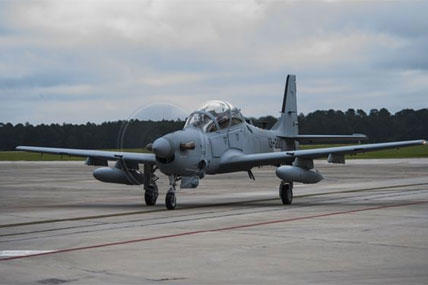The Afghan military will be without its own fixed-wing close air support for another fighting season this summer against the Taliban, with the first of 20 A-29 Super Tucano turboprops expected to begin arriving in December.
"This is a huge asset they're looking forward to getting inside Afghanistan," Army Gen. John Campbell told the House Armed Services Committee on Wednesday, but "they won't have much for the next fighting season."
The U.S. Air Force's $427 million program to provide A-29s to the Afghan military has been caught up in long-running contract disputes and delays in the training of Afghan Air Force air and ground crews, leaving the Afghan military overly-reliant on the U.S. for close air support in combat. The aircraft is made by the Brazilian aerospace company Embraer S.A.
Campbell, who took over the U.S. command in Afghanistan last summer, said that the first of the 20 A-29s should begin arriving in December. A few more will arrive next year but the majority of the order won't be fielded until 2017 and 2018 under the current schedule, he said.
In the questioning from lawmakers, Campbell gave a unique glimpse of how he operates in advising Afghan commanders in contact with the enemy. He said he constantly hears the plea from his Afghan counterparts: "I need close air support, I need close air support."
The general said, "What I tell the Afghans is, ‘Don't plan your operations wholly dependent on close air support. You have the capability. The Taliban doesn't have close air support, the Taliban doesn't have up-armored Humvees, the Taliban doesn't have D-30 howitzers.' So a part of it is just leadership, again."
He added, "The first thing I always get asked for is close air support. We're building their close air support.
"So when I get a request that says, ‘Hey, I need close air support,' the first thing I ask them is, ‘Do you have a Quick Reaction Force out there? Have you fired your mortars? Have you fired your artillery? Have you taken your Mi-17 (Russian helicopters) that have forward-firing machine guns on them? You have a few Mi-35s. Have you used them?'"
The Afghans also have a few MD530 "Little Bird" helicopters which can provide some close air support, but the MD530s are also caught up in a contract dispute. Last October, the Associated Press reported that the Justice Department was investigating allegations that an Army colonel sold inside information on the contract award.
While waiting for the A-29s, "We're working MD530s, which is a "Little Bird" that has two .50-caliber machine guns on the sides," Campbell told the Committee.
He also acknowledged frustration at the delays in getting the A-29s to the Afghans. "It is a very long process," Campbell said. "In hindsight, I wish we would've started that years ago," but "we are where we are. Quite frankly, we can't get it out there quick enough for them."
Embraer won the initial bid to provide a light air support aircraft for the Afghans against Hawker Beechcraft's AT-6B Texan aircraft. Hawker Beechcraft filed suit to contest the award, but Embraer won in court and the A-29s are now being made by Embraer and the Sierra Nevada Corp. in Jacksonville, Florida.
The A-29s began arriving at Moody Air Force Base near Valdosta, Georgia, last September to start training for 30 Afghan pilots and 90 maintainers.
"This is a very unique program, it's a great opportunity and it's definitely a great day for Moody Air Force Base," said Lt. Col. Jeffrey Hogan, the A-29 Light Air Support training unit commander.
"This aircraft is perfect for the mission. It's going to be a great opportunity for us to interact with the Afghans," Hogan said, according to the Air Force News Service. "We will be teaching them, but we will be learning from them as well."
"Specifically the mission that we are going to replace is the Mi-35 Helicopter, which is an attack helicopter, so they cover some of the same missions," Hogan said of the A-29s.
"But really this aircraft is a monumental leap in capabilities for the Afghan air force. It will allow us to do some overlap of those (Mi-35) missions and will do a lot better. It will also expand some other missions, which they currently cannot execute," Hogan said.
-- Richard Sisk can be reached at richard.sisk@military.com





























